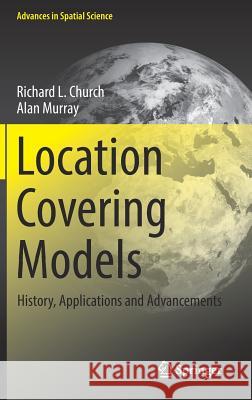Location Covering Models: History, Applications and Advancements » książka



Location Covering Models: History, Applications and Advancements
ISBN-13: 9783319998459 / Angielski / Twarda / 2019 / 271 str.
Location Covering Models: History, Applications and Advancements
ISBN-13: 9783319998459 / Angielski / Twarda / 2019 / 271 str.
(netto: 497,21 VAT: 5%)
Najniższa cena z 30 dni: 501,19
ok. 22 dni roboczych.
Darmowa dostawa!
This book provides a thoughtful and rigorous guide to coverage modeling, reviewing essential models, solution approaches, and related applications.
"This book will primarily be of interest to the student and practitioner in spatial questions, mainly with a geography, economics or engineering background and having already some basic knowledge of mathematical optimisation. It will be invaluable as a common source of ideas around the modeling of all kinds problems of optimal covering type." (Frank Plastria, zbMATH 1432.90004, 2020)
"If you want to teach LCMs to a group of undergraduate or graduate students then this book is what you are looking for. If you are new to LCMs and interested in learning more about it with the help of an extensive coverage of the literature, or if you know the theory and want to learn more about different research opportunities, then this book would be of interest to you." (Emre Tokgoz, Mathematical Reviews, July, 2019)
"I consider Location Covering Models to be an outstanding book that organizes the vast amount of literature concerning this topic in an excellent way. For this reason, no geographer who is engaged in spatial analysis should miss this book in one's library." (Gert W. Wolf, International Journal of Geographical Information Science, Vol. 33 (11), 2019)
Preface.- 1 Location Modeling and Covering Metrics.- 2 Classic Beginnings.- 3 Hierarchical, Coordinated, Multi-objective and Multitype.- 4 Probabilistic Coverage.- 5: Anti-cover.- 6 Weighted Benefit, Variable Radius, and Gradual Coverage.- 7 Capture, Capacities, and Thresholds.- 8 Continuous Space Coverage.- 9 Disruption, Protection, and Resilience of Service Coverage.- 10 Coverage of Network‐Based Structures: Paths, Tours and Trees.- 11 Grand Challenges.
Richard Church is a Distinguished Professor, Emeritus of Geography and formern Associate Dean of the Sciences at the University of California, Santa Barbara. He received his PhD in Environmental Engineering from The Johns Hopkins University. Before joining the faculty at UCSB, he was an Associate Professor of Civil Engineering at the University of Tennessee. He has taught courses in Geography, Business, Industrial Engineering, and Civil Engineering. Prof. Church’s research is concentrated on spatial optimization and Geographic Information Science applied to transportation systems, location and logistics, urban systems and environmental natural resource protection. He has published more than 250 papers in Regional Science, Geography, Transportation, Operations Research, Environmental Modeling, and Engineering. Dr. Church has served as a consultant to a number of companies and governmental agencies on a wide variety of problems (logistics, environmental management, site selection, and transportation). He is a Fellow of the Regional Science Association International and a Fellow of the American Association for the Advancement of Science (AAAS). He received the outstanding Graduate Mentor Award from the University of California, Santa Barbara in 2013, the Lifetime Achievement in Location Award (INFORMS) in 2012, and the University Consortium for Geographical Information Science Research Award in 2014. In 2015 he served as President of the North American Regional Science Council and is currently President of SOLA (a section of INFORMS).
Alan Murray (BS, MA, PhD UC Santa Barbara) is a Professor in the Department of Geography at University of California at Santa Barbara. He previously held academic appointments at Drexel University, Arizona State University and Ohio State University. He is editor of International Regional Science Review, associate editor and/or editorial board member for a range of international journals, including Geographical Analysis, Transactions in GIS, Papers in Regional Science, Computers, Environment and Urban Systems, Socio-Economic Planning Sciences and Annals of the Association of American Geographers. His research and teaching interests include: geographic information science; spatial optimization; health informatics; urban growth and development; land use planning; urban, regional, and natural resource planning and development; and, infrastructure and transportation systems. He is the author of two books and over 220 research articles, book chapters and proceedings papers. Finally, he is the recipient of the 2015 Walter Isard Award for Scholarly Achievement from the North American Regional Science Council.
This book provides a thoughtful and rigorous guide to coverage modeling, reviewing essential models, solution approaches, and related applications. Since the early developments of the Location Set Covering Problem and the Maximal Covering Location Problem, models based upon some form of coverage have been extended and applied in a number of areas, helping to improve services offered to citizens of large cities and regions. Examples include trauma care services, transit systems design, cell tower location, and many others. The book not only describes the strengths and weaknesses of currently available models, but also presents details on major developments, including solution procedures and applications, making it well suited both as a reference text and a textbook for graduate level courses.
1997-2026 DolnySlask.com Agencja Internetowa
KrainaKsiazek.PL - Księgarnia Internetowa









